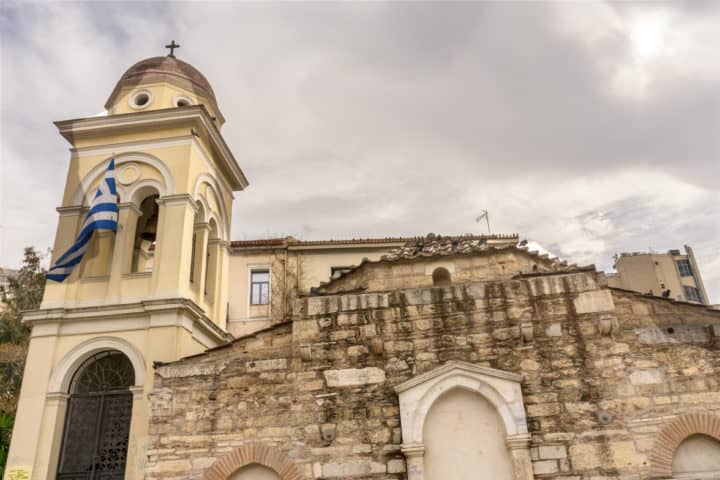 Byzantine Athens – Part Two of the Capital Most Famous Medieval Churches
Byzantine Athens – Part Two of the Capital Most Famous Medieval Churches
After finding Panagia Pantanassa in Monastiraki, Panagia Kapnikarea on Ermour Street and Agoii Apostoli in the Ancient Agora, there are three other famous churches that rank among Athens’ most popular Byzantine Churches. These are the Church of Sotira Lykodemou, the Church of Sotira tou Kottakis, and the Church of Panagia Gorgeopikoos.
Sotira Lykodemou – Σωτείρα Λυκοδήμου
– Area: Close to Syntagma Square between Philellinon St and Queen Amalia Avenue
– Type: Octagon
– Date: 1st half of 11th C.
About The Church of the Savior of Lykodemos
The Church of the Savior of Lykodemos [Greek: Σωτείρα Λυκοδήμου] is the largest and most elegant building surviving from the medieval period in Athens. It was originally the Katholikon [or main church] of a monastery, and was surrounded on all sides by other monastic buildings. Its exterior is extensively decorated with ornate Byzantine brickwork known as cloisonné. In between the stone runs additional lines of triangular looking brick edges that are known as ‘dog-tooth’ patterns.
It is best known as a Russian church, as the Russian Government bought it in the 19th Century for the Russian community. The Russians added the tall bell tower and restored the heavily damaged church, giving it the appearance it has today. Unfortunately this replaced the original Byzantine features of the interior such as the iconography. The short ornate Byzantine Iconostasis was replaced with a taller Russian-style Icon screen No original wall paintings remain, but the architecture is an excellent example of larger Byzantine churches.
Sotira tou Kottakis – Σωτείρα Κοττάκη
– Area: Plaka on the corner of Sotirios and Kidathineon
– Type: Cross in Square
– Date: Beginning of 11th C.
About Sotira Kottaki
The name Sotira Kottaki [Greek: Σωτείρα Κοττάκη] comes from its previous owners, the Kottakis family. It is a complex four-columned; cross-in-square church dated to the first half of the 11th century. This meant that arches connected the four columns in the shape of a square, and the cylindrical dome rests on the tops of the arches. The church was severely damaged in the Greek War of Independence, and its subsequent restoration altered its original form considerably. The church houses a miraculous icon of the Virgin Mary that dates from the 14th Century. In the church’s shady courtyard, one can find the remains of ancient columns dating from the Roman Era.
Agios Eleftherios – Άγιος Ελευθέριος [also known as: Panagia Gorgeopikoos /Little Mitripoli]
– Area: Mitropoleos Square
– Type: Cross in Square
– Date: End of the 12th Century
About The Church of Panagia Gorgeopikoos
The Church of Panagia Gorgeopikoos [Greek: Ναός της Θεοτόκου Γοργοεπήκοου] was constructed at the end of the 12th Century under the order of the Bishop of Athens. Its named refers to the Virgin Mary ‘who is quick to hear’. After the founding of the Modern Greek state, it was repaired and rededicated to Hagios Eleftherios in 1863. It is one of the only churches that has maintained its original form. It is built mostly of marble blocks, and its walls feature rich sculptural decoration, some dating back to the times of Ancient Athens.
Today it is located in Mitropoleos Square right next to the south side of the Athens Metropolitan Cathedral [Megalo Mitropoli]. Dwarfed by the Cathedral, it has earned the nickname ‘little, or Mikro Mitropoli’.

 Byzantine Athens – Part Two of the Capital Most Famous Medieval Churches
Byzantine Athens – Part Two of the Capital Most Famous Medieval Churches